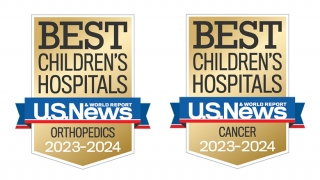Enchondroma
What is an enchondroma?
An enchondroma is a benign tumor that forms in the central part of the bone where bone marrow is stored. Enchondromas are made up of cartilage, a tough, flexible connective tissue found in many areas in the body.
Enchondromas often occur in the small bones of the hand and feet or in the long bones of the arms and legs. Enchondromas most commonly affect patients between 10 and 20 years old. Males and females are equally affected.
Most enchondromas are discovered as single tumors, and do not require treatment. In rare cases, multiple enchondromas can develop, weaken the bone and cause it to break or deform. In these cases, surgery may be needed to remove the tumor and stabilize the bone.
If your child has many enchondromas, he may be diagnosed with a syndrome called Ollier’s disease. Children with Ollier’s disease can develop uneven growth of their limbs.
Causes of enchondromas
The cause of single enchondromas is unknown. Researchers believe multiple enchondromas are caused by a gene error that results in abnormal bone formation.
Signs and symptoms of enchondromas
Enchondromas are usually painless and are often found accidently for a non-related injury. Enchondroma of the hands and feet is suspected when fingers become enlarged, or fractures or deformities occur.
If pain is a symptom — whether generalized pain or when bones are at rest — this may indicate a malignant tumor, although this is extremely rare.
Testing and diagnosis for enchondromas
At Children’s Hospital of Philadelphia (CHOP), our clinical experts use a variety of diagnostic tests to diagnose enchondroma in your child, including:
- X-rays, which produce images of bones.
- EOS imaging, an imaging technology that creates 3-dimensional models from two planar images. Unlike a CT scan, EOS images are taken while the child is in an upright or standing position, enabling improved diagnosis due to weight-bearing positioning.
- Magnetic resonance imaging (MRI), which uses a combination of large magnets, radiofrequencies and a computer to produce detailed images of organs, soft tissues, muscles, ligaments and other structures within the body. Your child is exposed to no radiation during an MRI.
- Computed tomography (CT) scan, which uses a combination of X-rays and computer technology to examine bones and produce cross-sectional images (“slices”) of the body.
- Needle biopsy, which is a procedure where a doctor places a small needle through the skin and into the lesion to withdraw a small sample of the abnormal tissue. The tissue is analyzed to confirm any findings.
Treatments for enchondromas
There are many treatment options available for bone and soft tissue tumors, and some children will need a combination of these therapies. At CHOP, experts at the Bone and Soft Tissue Tumor Program take a team approach to treatment. Orthopaedic, cancer and other specialists collaborate to provide your child with individualized care and the best possible outcomes.
Our program is led by Kristy L. Weber, MD, and Alexandre Arkader, MD, nationally renowned surgeons who specialize in treating bone and soft tissues tumors, limb-sparing surgery and reconstructive surgery.
If your child’s enchondroma is not causing any symptoms, clinicians generally recommend a “watch-and-see” approach that includes ongoing monitoring to ensure the tumor does not grow.
However, if the enchondroma gets larger, becomes painful, or causes a broken bone, surgery to remove the tumor may be recommended.
Surgical treatment may include:
- Intralesional curettage, which involves scraping out the bone to completely remove the tumor
- Intraoperative adjuvants — such as cryotherapy (liquid nitrogen), phenol (a chemical) or cauterization (burning the tumor bed) — which are used to remove microscopic tumor cells
- Bone grafting, a surgical procedure to replace missing bone with artificial graft material or cadaver bone
Depending on the size and location of enchondroma removed, your child may be able to return home that day or may spend one night in the Hospital.
Enchondromas that appear in the head or neck and require specialized surgery will be treated by a surgeon from the Head and Neck Disorders Program at CHOP.
Surgical safety
Though surgery for tumors is highly effective, we understand that any surgery can be a stressful experience for children and families. At CHOP, we offer a wealth of resources about how to prepare your child for surgery and what to expect during surgery.
Additionally, we employ numerous best practices before, during and after surgery to decrease the risk of infection and increase positive outcomes. For more details about safety protocols at Children's Hospital of Philadelphia, see safety in surgery.
Follow-up care
Follow-up care for enchondroma will depend on what treatment your child received.
If the tumor was surgically removed, your child will see the orthopaedic surgeon about one to two weeks after surgery, then again at three and six months post-surgery.
If your child was not experiencing symptoms and doctors recommended watchful waiting, ongoing monitoring will be needed. During follow-up visits, X-rays and other diagnostic testing of the tumor site are recommended to closely monitor your child’s health.
Follow-up care and ongoing support and services for your child and family are available at our Main Campus and throughout our CHOP Care Network. Our team is committed to partnering with parents and referring physicians to provide the most current, comprehensive and specialized care possible for your child.
If your child was diagnosed with multiple enchondromas (Ollier’s disease) and develops uneven growth of his limbs, he may need additional surgery to realign or lengthen the shorter limb. At CHOP, our experts in the Bone and Soft Tissue Tumor program have special expertise in the management of limb deformities.
Outlook
The long-term outlook for a child with a single enchondroma is excellent.
Children with multiple enchondromas (Ollier’s disease) have a chance — 25-30 percent — of developing a cancerous growth called chondrosarcoma that develops from one of the enchondromas.
Reviewed by Kristy L. Weber, MD, FACS, Alexandre Arkader, MD



